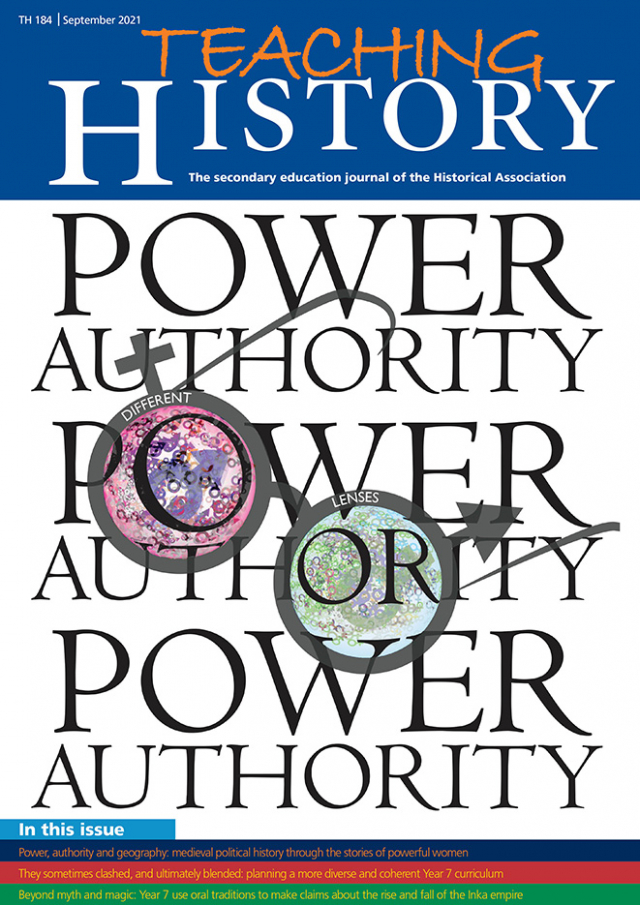Teaching History 184: Out now
The HA's journal for secondary history teachers

Editorial: Different lenses
Read Teaching History 184: Different lenses
For millennia, human beings have used lenses as tools: to help them see further, to magnify or to correct defects of vision. Yet lenses can distort as well as illuminate the unseen.
Robert Hooke, the seventeenth-century scientist who helped popularise the microscope through his famous book Micrographia, was better placed than most to appreciate both the power and perils of lenses. Describing his efforts to study the microscopic structure of rocks, plants, and insects, he lamented ‘… of these kind of Objects, there is much more difficulty to discover the true shape, than of those visible to the naked eye, the same Object seeming quite differing, in one position to the light, from what it really is, and may be discover’d in another.’1 Thus Hooke’s famous images, which translated a three-dimensional world into a two-dimensional form, are not in fact representations of what he ever saw through a microscope, but rather re-creations, based on many sightings through different lenses.2 Hooke’s work with microscopes is perhaps an apt metaphor for the work of historians. We cannot simply discard lenses, for without them we cannot see. Yet, as Hooke recognised, the very act of looking at and representing an object alters it.
All the articles in this edition are concerned with the lenses historians use to look at the past and to represent it. Paula Worth and Stuart Farley each address the uses historians have made of frameworks and methodologies drawn from other subject disciplines in order to gain new insights on the past, whether by asking different questions or by viewing it from a different perspective. Worth offers an account of the opportunities and challenges that she faced when introducing her Year 7 pupils to oral traditions as part of an enquiry on the Inkas. She shows how scholarship from history and anthropology shaped her decisions about how to treat oral traditions, in all their richness and complexity.
In seeking to introduce his pupils to a more complex history of the Holocaust, one which acknowledged the diversity of experiences across time and space, Farley took his inspiration from the historian Tim Cole, whose work on the Holocaust has been shaped by the geographical concepts of place and space. Farley reflects on how building an enquiry around these concepts altered the narrative he presented to pupils, and consequently their understanding of the complexity of the Holocaust as a phenomenon.
In contrast, Dhwani Patel looked to frameworks and methodologies used within the historical discipline when searching for a way to develop her pupils’ historical understanding. Drawing on her experience as an historian, and her own research, Dhwani Patel reflects on how the methodological approaches commonly used in the sub-discipline of cultural history can be used to help develop more nuanced understandings of political history. She offers an account of her rationale and practical decision-making when planning an enquiry for Year 7 pupils that translated her own research on the rituals of the medieval papacy into the Key Stage 3 classroom.
Elizabeth Carr was also interested in the nature and functioning of political power in the medieval period. Searching for greater rigour than her department’s existing schemes of work allowed, she adopted a conceptual lens. Inspired by the historian Helen Castor’s work on medieval queens, Carr explored how viewing medieval kingship using the concept of gender can reveal new facets of the workings of power in the period. She also shows how gender became one of the lenses her department has used to help shape its Key Stage 3 curriculum as a whole and to give it greater coherence.
Maya Stiasny shares with Carr an interest in how focusing on a particular group within society can illuminate broader patterns and trends. Determined that her department’s quest to diversify the curriculum should not end with Key Stage 3, Stiasny incorporated recent research on the experiences of black Germans in Weimar Germany into her A-level schemes of work. In setting out her rationale, she argues that teaching the experiences of marginalised groups not only helps reveal a more complex past, but can encourage students to question conventional narratives.
Like both Carr and Worth, Jacob Olivey is concerned with the coherence of the curriculum as a whole. Searching for new forms of curricular coherence, he began to question his approach to the selection and sequencing of substantive content, especially in the light of his department’s desire to diversify topics and perspectives. Convinced that the answer to a narrow and fragmented curriculum did not lie in a linear national narrative, Olivey shows how he drew on historical scholarship to build substantive coherence via a focus on particular places and changing ideas.
References
1. Robert Hooke, Micrographia (1665) cited in Spiller, S. (2004) Science, Reading and Renaissance Literature: the art of making knowledge, 1580–1670, Cambridge: Cambridge University Press, p. 154.
2. Doherty, M.C. (2012) ‘Discerning the “true form”: Hooke’s Micrographia and the visual vocabulary of engraved portraits’, The Royal Society, notes recorded at/by the Royal Society (2012) 66, 211–234 https://doi.org/10.1098/rsnr.2012.0031

